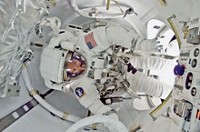Advertisement
Grab your lab coat. Let's get started
Welcome!
Welcome!
Create an account below to get 6 C&EN articles per month, receive newsletters and more - all free.
It seems this is your first time logging in online. Please enter the following information to continue.
As an ACS member you automatically get access to this site. All we need is few more details to create your reading experience.
Not you? Sign in with a different account.
Not you? Sign in with a different account.
ERROR 1
ERROR 1
ERROR 2
ERROR 2
ERROR 2
ERROR 2
ERROR 2
Password and Confirm password must match.
If you have an ACS member number, please enter it here so we can link this account to your membership. (optional)
ERROR 2
ACS values your privacy. By submitting your information, you are gaining access to C&EN and subscribing to our weekly newsletter. We use the information you provide to make your reading experience better, and we will never sell your data to third party members.
Policy
Going Beyond The Moon
Space Policy: President Obama provides details of his plan for the future of human space exploration
by Susan R. Morrissey
April 16, 2010

The National Aeronautics and Space Administration must focus its efforts on developing new technology needed to carry humans into space rather than on a specific destination, President Barack Obama said in an April 15 speech at NASA's Kennedy Space Center in Florida. His remarks were the first covering his new plan for the agency's human space exploration program.
"Fifty years after the creation of NASA, our goal is no longer just a destination to reach," Obama said. "Our goal is the capacity for people to work and learn and operate and live safely beyond the Earth for extended periods of time, ultimately in ways that are more sustainable and even indefinite."
The plan outlined by Obama is a slight revision of one included with his fiscal 2011 budget proposal released in February (C&EN, Feb. 15, page 16). That plan provided few details beyond cancellation of the Constellation Program—the space agency's current effort to build new spacecraft to return astronauts to the moon before venturing to Mars. It outlines a new focus on technology development and increased commercial sector involvement.
The revised plan described by the President this week now includes development of an International Space Station rescue vehicle based on the Orion crew capsule that is part of the Constellation Program. It also invests more than $3 billion to develop a heavy lift rocket that can carry crew capsules and supplies into deep space. A design for such a rocket is to be finalized by 2015 with construction to follow.
According to Obama, human missions beyond the moon are expected to be possible by 2025 with the likely first target being an asteroid. By the mid-2030s, he expects human missions to obit Mars and return to Earth with martian surface landing missions after that.
Members of Congress remain cautious about the President's plan.
"As with most presidential proposals, Congress will not just rubber stamp it," said Sen. Bill Nelson (D-Fla.), who chairs the Senate Science & Space Subcommittee that oversees NASA. "So we'll take what he's saying to our committee, and then we'll change some things."
"The President's announcement today, unfortunately, still will do nothing to ensure America's superiority in human space exploration," said Rep. Ralph Hall (R-Texas), the ranking Republican on the House Science & Technology Committee, which has NASA oversight. "I agree with Neil Armstrong, Apollo astronauts, and many other supporters of our space program who believe that the President's proposal would be devastating for the future of NASA."
House and Senate hearings on the plan are expected.
For the President, however, his vision for the future of space exploration is just what NASA needs to be successful.
"The bottom line is nobody is more committed to manned space flight, to human exploration of space than I am," Obama said. "But we've got to do it in a smart way, and we can't just keep on doing the same old things that we've been doing and thinking that somehow is going to get us to where we want to go."



Join the conversation
Contact the reporter
Submit a Letter to the Editor for publication
Engage with us on Twitter